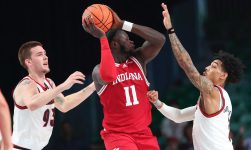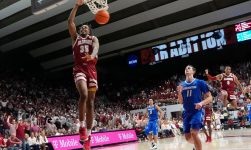The Telegraph
Grand predictions crushed as Jon Rahm’s horrible miscue leads to ‘pretty awful’ round
If ever you see the world’s No 2 golfer stone-cold top one off the heel, you can typically be sure that he means it. Jon Rahm emphatically did during the Masters practice round where he skimmed his ball across the pond at the 16th, judging the contact to such perfection that after three hops, it took the green’s slope to arc inexorably into the cup. Alas, when the Spaniard stood on the 8th fairway on Saturday night and produced another shot that barely left the ground, it was horribly unintentional. Full leaderboard Finding the ball beneath his feet, Rahm looked to shape it right-to-left into the par-five but miscued dismally with a shortened backswing, watching it dive viciously left into the trees. Not unreasonably, he glowered at the club as if he wanted to snap it in half. It is one of the Masters’ many mysteries that this 570-yard hole, which should yield a regulation birdie for a player of his length, has sent his game haywire before. Last year, in the very same place, he hit one of the worst shanks seen outside a monthly medal. One such lapse can be excused, but repeating it threatens to leave a mental scar. Rahm did not take kindly to being asked to describe his round, where one gruesome error extinguished any momentum en route to a 72 that left him seven adrift of Dustin Johnson’s lead. “Seriously, how would I describe it? Pretty awful,” he said, tersely. “I was playing good golf and got a great mud ball. There’s no way I can be happy about it. The course was there for scoring, and I couldn’t take advantage of anything. I fought my a– off at the end to salvage an under-par round and I couldn’t. I’ve got to shoot a miracle score to have a chance.” In all honesty, the fashionable excuse of a “mud ball” did not do justice to the awfulness of the stroke. For Rahm, the worst aspect of it all was the timing. As he approached the turn, he was surging up the leaderboard in the hunt for Johnson, just as the world rankings suggested he would. But on a hole he had hoped to eagle, he sloped off instead with a double-bogey that effectively snuffed out his quest for a maiden major. While the damage had begun with his inexplicable grubber from the short grass, Rahm soon compounded it by firing his third shot straight into a loblolly pine, off which it duly ricocheted into a bush. A seven was all he could muster in the end, enough to wipe away his hopes. In the space of one hole, Rahm’s gait lost its usual bounce. He had talked up the drama of this third round, predicting a shoot-out of all the leading names, and instead he let Johnson, his rival for the No 1 spot, drift into the distance unchallenged. It was a dispiriting, lost opportunity for a man who, in the week of his 26th birthday, had the game to command this tournament. He had won two titles on the PGA Tour, and could point to top-10 finishes in three of the four majors. Plus, there was the relentless training at home in Arizona throughout this disjointed season, knowing that all roads led to Augusta. Rahm is not averse to making grand predictions about his prospects. For him to win the Masters, he declared, he needed only to stay true to who he was. “I need to play the shot that I see and feel within me,” he said. “Not the shot that you’re supposed to play. Hit the shot that I feel in my moment, in my hands and in my mind. Just be who I am.” For Rahm, that moment arrived on the eighth and he proved spectacularly unequal to it. Loath as he is to admit any weakness, his swing sometimes becomes rushed and abbreviated when the pressure rises. So it turned out in this third round, as he produced the type of mistake that would haunt his sleep. After the early bolts by Rahm, Paul Casey and Lee Westwood, this Masters has taken a sour turn for the European contingent. Rory McIlroy made a tireless effort to reel in Johnson, his friend and fellow member of the Bear’s Club in Florida, but looked likely to continue the pattern where his major is derailed by one poor round. His opening 75 was a cardinal sin against a rival of Johnson’s calibre. Instead, Europe’s finest were left to marvel at the exploits of Bernhard Langer, who stepped off the course at two under. It is not just the fact that, at 63, the German has become the oldest player in Masters history to make the cut, breaking Tommy Aaron’s record by 33 days, but that the birth dates of his fellow competitors in majors span an entire century. Gene Sarazen, whom he faced in the 1976 Open at Royal Birkdale as an 18-year-old, was born in 1902. As for Abel Gallegos, the Argentinian amateur who qualified for Augusta this year? 2002. It is one of golf’s greatest virtues that such a feat is even possible within a single career. But it is also a tribute to Langer’s longevity that his powers have yet to attenuate on a course whose length is traditionally unkind to those in their seventh decade. He is a living, breathing museum piece.






